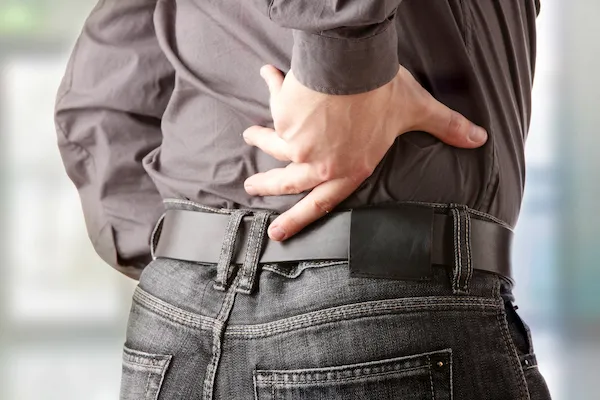Spine and Nerve Conditions
At Key Clinics, our professional medical staff led by Dr. Joel D. Siegal, a board-certified neurosurgery spine surgeon, works to provide people with spine and nerve conditions much-needed relief. We care for patients throughout Mid-Ohio suffering from a variety of spine and nerve conditions, such as those mentioned below.

Although more spine and nerve conditions exist beyond those listed, these represent the most common complaints:
- Ankylosing Spondylitis – This form of arthritis most often affects the joints and ligaments of the spine primarily in the lumbar region. With progression, some people develop a posture that makes it look as though they are stooping over.
- Cervical Disc Rupture – With this condition, the disc, or cushion between the bones of the cervical spine, ruptures causing extreme pressure on the nerves leaving the spine leading to debilitating neck and arm pain, numbness, tingling and possibly weakness.
- Compression Fracture – Both minor and major trauma can cause a compression fracture or broken vertebra of the spine. Motor vehicle crashes, osteoporosis and cancer can cause the vertebrae to break or fracture. Although a compression fracture can occur anywhere along the spinal column, the junction between the thoracic and lumbar spine is the area most affected.
- Degenerative Disc Disease – Between healthy vertebrae are cartilaginous discs that act as natural shock absorbers. With age, some peoples’ discs dry up and shrink. When that happens, the discs lose their cushioning capability and can become painful due to the degeneration.
- Kyphosis – Affecting both children and adults, kyphosis is a progressive disorder that leads to a forward bending/curvature of the spine. Although there are many different causes, the most common include compression fractures, trauma, arthritis, osteoporosis, and developmental problems.
- Low Back Pain – Of all spine and nerve conditions, pain in the lower back region is by far the most common. At Key Clinics, we identify the cause, whether a compression fracture, aging, strain, overuse, injury, osteoporosis, or arthritis. Based on the findings, Dr. Siegal develops an effective treatment plan.
- Lumbar Disc Disease – The low back or lumbar spine consists of five vertebrae, each separated by discs of cartilage that act as cushions. When a trauma or degenerative condition damages a disc, the jelly or fluid inside the disc can bulge/herniate out causing back and leg pain by putting pressure on the nerves in the spinal canal.
- Myelopathy – When the spinal cord stops working well, it’s called a myelopathy. Spinal stenosis or “squishing” of the spinal cord is usually due to a spinal injury, herniated disc or arthritis. If the spinal cord is not working right, people can develop numbness, weakness, difficulty with balance, walking, use of arms/hands or legs as well as bowel/bladder issues. It’s important to see Dr. Siegal as soon as possible to determine if your situation can be treated to minimize permanent long term problems.
- Radiculopathy – Radiculopathy refers to pain going into the arms or legs as a result of a nerve near the spinal column being pressed. Cervical radiculopathy indicates pain, numbness and weakness extending from the neck into the arms and/or hands due to a nerve root being compressed in the neck. Lumbar radiculopathy is similar but indicates that the problem is centered in the lower back extending into the legs and feet. The usual culprits of radiculopathy are one or more herniated discs, everyday wear and tear, disc degeneration, or a traumatic injury.
- Sciatica – Multiple nerve roots coming out of the lumbar spine form the sciatic nerve that enters the leg via the buttocks. Sciatica occurs when this nerve or the nerve roots that form it are irritated. Patients with sciatica typically experience varying degrees of numbness, pain and tingling into the legs and feet. Spinal stenosis, a herniated disc, arthritis or some type of injury leading to a pinched nerve are the most common causes.
- Scoliosis – Scoliosis refers to a curvature of the spine. The curvature can start in childhood or during the teenage years. Some people develop the curve in adulthood as their arthritis worsens. While some people have only a slight curvature of the spine, others develop a much more severe case.
- Spinal Arthritis – Just as arthritis affects joints in the hands, knees, and feet, it can also cause problems in the cervical, lumbar, pelvic and sacroiliac joint regions. In addition to a loss of motion, this spine condition can cause pain. Regardless of the involved area, vertebrae and cartilage wear abnormally.
- Spinal Stenosis – This spine and nerve condition is caused by spinal canal narrowing in the cervical, thoracic or lumbar regions leading to spinal cord or spinal nerve pinching. When that happens, sharp pain can radiate into the neck/arms, chest or back/legs. Although spinal stenosis typically affects more senior patients, someone born with a small spinal canal could develop the same condition and symptoms at a much younger age.
- Spondylolisthesis – Typically, spondylolisthesis occurs in the lower back region and describes a vertebra that slips forward in the spinal column. While some people have this spine and nerve condition at birth, others develop it due to a disease, infection, trauma, or stress fracture. When the spine is out of alignment, the nerves can become compressed and cause severe back/leg pain, numbness and tingling.
We Dramatically Change the Quality Of Life For Our Patients -